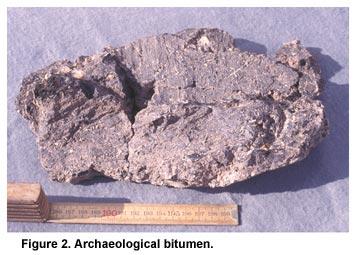
| FAMSI © 2006: Carl J. Wendt |
||
Bitumen Sourcing in the Olmec Region Bitumen in Mesoamerica Prehispanic Mesoamerican peoples collected, processed, and used bitumen for decoration, as a sealant, and as an adhesive. Among the earliest to do so were the Olmec (1200-500 B.C., radiocarbon years) of México's southern Gulf coastal lowlands. Bitumen (Figure 2; commonly called asphaltum in the United States and chapopote in México) is one of the few naturally occurring substances of potential trading value that is found in the Olmec region. It is unique since it preserves well in the archeological record and is found at all types of Gulf lowland archaeological sites, as well some sites in the Central Mexican Highlands. Bitumen, chemically made up of a mixture of complex natural hydrocarbons and oxidized products, is what remains of certain crude oils upon the elimination of volatile components. Various analytical techniques including stable isotopic analyses, gas chromatography/mass spectroscopy (GC/MS), compound-specific-isotopic-analysis (CSIA), and gas-chromatography-combustion-isotope ratio-mass spectrometry (GC/C-IRMS) have been successfully used to source archaeological bitumen in ancient Greater Mesopotamia and Egypt where bitumen had an important role in regional economies (Connan 1999; Connan and Deschesne 1992; Connan et al. 1998; Harrell and Lewan 2002; Maurer et al. 2002; Nissenbaum 1992; Nissenbaum et al. 1984; Schwartz et al. 2000). These analyses were successful because some of the bitumen hydrocarbons serve as molecular biomarkers, which were useful for 'fingerprinting' the material. In Mesoamerica, natural bitumen seeps occur in pockets along the Gulf coastal plain and offshore in the Gulf of México. In the Olmec region, bitumen seepages are limited to the eastern, low-lying areas, which include the regional centers of San Lorenzo and La Venta. In these locales bitumen could be collected right off the water's surface (e.g., ocean, rivers), from beaches, and from seeps. It was then processed by mixing it with mineral or vegetal additives so it will stiffen upon application and not readily melt in the sun (Wendt 2003; also see Connan and Deschesne 1992; Forbes 1936:42-45). Archaeological data indicate that the Olmec used bitumen as a sealant (e.g., basalt aqueduct troughs, canoes), an adhesive, a decoration (e.g., on figurines, knife handles), and a building construction material (to coat walls or floors) (Coe and Diehl 1980:152, 260; González Lauck 1996; O'Rourke 2002; Ortíz and Rodríguez 1989, 1994; Rodríguez and Ortíz 1997; Wendt 2003). I suspect that the most important use, however, was to waterproof canoes and other watercraft (e.g., rafts, reed boats). Because much regional trade, communication, transportation, and subsistence was tied to waterways (Symonds et al. 2002), it would have been critical for the Olmec to possess effective watercraft. In post-Olmec Prehispanic times, bitumen continued to be an important commodity in many parts of Mesoamerica, where it was used for decoration, building construction, waterproofing, adhesive, chewing gum, incense, body adornment, paint, and fuel (de la Fuente 1992; Ekholm 1944; Hall 1997; Medellín 1960; Sahagún 1961; Solís 1992; Stark 1977; Tozzer 1941). Today, local people continue to use bitumen for its waterproofing qualities, such as for sealing canoes (with purchased bitumen, however) and for surfacing patios, floors, and roads (in areas near natural seeps). The distribution of archaeological bitumen in zones located at far distances from seeps indicates that the Olmec and their successors traded the substance within and outside the Gulf region. The small spheres (ca. 2 cm in diameter) and larger cakes found in excavations (Wendt 2003) appear ideal for long-distance trading, and one large bitumen sphere (ca. 12 cm in diameter) found next to the right foot of a 40-45 year-old male skeleton at the Early Pre-Classic site of Tlatilco in the Basin of México (García Moll et al. 1991) provides concrete evidence of Pre-Classic period long-distance bitumen exchange. |
||
|
Text links to all pages at this site are available at the FAMSI INDEX |
||
